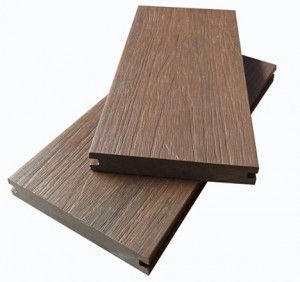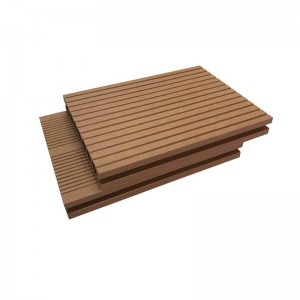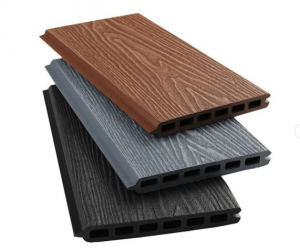Wpc solid deck of wpc decking board from China Suppliers
Product specifications
Model
Solid
Type
Decking board
Style
Grooved
Component
Composite
Color
7 COLOR
Thickness
30 mm
Width
140 mm
Length
2.2m-5.8m
Warranty
25-Year limited warranty
What isAdvantagesUsed ForInstallationFAQManufacturerFeedback
WPC Solid Decking Board
WPC Composite decking boards is made of 30% HDPE (Grade A recycled HDPE),60% Wood or Bamboo powder (Professionally treated dry bamboo or wood fiber), 10% Chemical Additives(Anti-UV agent, Antioxidant, Stabilizes, Colorants, Lubricant etc.)
WPC composite decking not only has real wood texture, but also has longer service life than real wood and requires little maintenance. So, WPC composite decking is a good alternative of other decking.
WPC (abbreviation: wood plastic composite)
Advantages of WPC (Wood Plastic Composite)
1. Looks and feels like natural wood but less timber problems;
2. 100% recycle, eco-friendly, saving forest resources;
3. Moisture/Water resistant, less rotten, proven under salt water condition;
4. Barefoot friendly, anti-slip, less cracking, less warping;
5. Requires no painting, no glue, low maintenance;
6. Weather resistant, suitable from minus 40 to 60°c;
7. Easy to install and clean, low labor cost.
Wood plastic composites (WPCs) are composites made of wood elements and plastic fibers. WPCs can be made entirely of recycled materials and plastic powder obtained from woodwork manufacturing facilities. WPC, also known as composite wood, is widely used in the construction of outdoor deck floors, prefabricated houses, park benches, door frames, and indoor and outdoor furniture. This paper explains the manufacturing, characteristics and advantages of WPC in architecture.
Manufacturing of wood plastic composites (WPC)
Wood plastic composites are made by fully mixing ground wood particles with heated thermoplastic resin. Finally, the whole mixture is extruded into the desired shape. Commonly used thermoplastic resins include polystyrene (PS), polylactic acid (PLA) and polypropylene (PP).
Mixing and extrusion processes vary by manufacturing facility. WPC contains organic raw materials, which need to be processed at a lower temperature than traditional plastic composites to promote extrusion and injection molding. The ratio of wood to plastic in composites determines the melt flow index (MFI) of WPC. Large amount of wood leads to low MFI.





